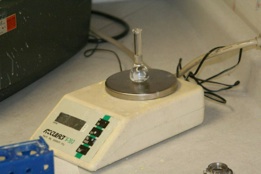One of the most common slurry tests performed for investment casting slurries is SiO2 percentage. Insufficient concentration of SiO2 in the slurry creates a weak shell. However, having too high a concentration can also cause a weak shell while potentially gelling the slurry.
The two common methods for measuring binder solids are volumetric and through the use of a densitometer. For this discussion, we will focus on the volumetric method.
Ensure that the sample has been spun long enough to remove the refractory particles from the supernate (liquid on the top of the solids). If this isn’t done, the results will be inaccurate, regardless of the test method utilized.
Of the two methods, the volumetric procedure can lead to the most variability. This variability can come from the following:
1. Uncalibrated flasks
2. Dirty flasks
3. Fill line identification
 Most foundries make the mistake of assuming that a 10 ml volumetric flask filled with water will weigh10 grams. Making this assumption could lead to inaccurate results. However, if you compound this error with a dirty flask and the results will be even further off. I have seen the percentage of silica be off by up to 3 percentage points by not calibrating a dirty flask.
Most foundries make the mistake of assuming that a 10 ml volumetric flask filled with water will weigh10 grams. Making this assumption could lead to inaccurate results. However, if you compound this error with a dirty flask and the results will be even further off. I have seen the percentage of silica be off by up to 3 percentage points by not calibrating a dirty flask.
The other challenge that operators sometimes face is knowing how to locate the meniscus. By going through the calibration process, this can help operators understand how a slight difference in the fill line can impact the results.
The ICI has outlined a procedure on how to calibrate your flasks every time the test is performed. Or, if you have questions, feel free to contact me for more information at Julie@keyprocessinnovations.com.
